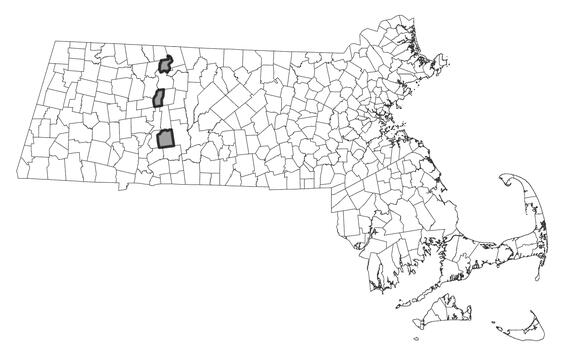- Scientific name: Aplectrum hyemale (Muhl. ex Willd.) Nutt.
- Species of Greatest Conservation Need (MA State Wildlife Action Plan)
- Endangered (MA Endangered Species Act)
Description
Putty-root (Aplectrum hyemale). Photo credit: Bryan Connolly
Putty-root is a glabrous (hairless), herbaceous perennial in the orchid family (Orchidaceae). It rises from globose corms (dense, vertical, underground stems, as in Gladiolus) that are filled with a glutinous matter. These corms usually occur in pairs. Putty-root's single, blue-green, elliptic basal leaf does not develop until late summer and is 10-20 cm (4-8 in.) long. By flowering season, from late May to mid-June, the leaf has usually withered. Putty-root's 3-6 dm (12-23 1/2 in.) high scape, or flower stalk, has only a few sheathing bracts (modified leaves associated with flowers). It has seven to fifteen, greenish, yellowish, or whitish flowers marked with reddish-purple, which occur in a raceme (an elongate, unbranched axis with stalked flowers). Three greenish or yellowish, spreading sepals (members of the outermost floral whorl) subtend shorter petals that arch over the fused male and female flower parts. The lip, or lowermost petal, is three-lobed, whitish, and spotted with magenta. (The rare albino forms lack this spotting.). The crane-fly orchid (Tipularia discolor) somewhat resembles putty-root. However, crane-fly orchid's sepals and lateral petals are greenish-purple, and the lip is purple with two rounded basal lobes.

Population status
The MassWildlife’s Natural Heritage & Endangered Species Program database has 8 records from 2 counties: Franklin and Hampshire. Only 3 of these records have been observed within the last 25 years.
Distribution and abundance
Putty-root is native to the eastern deciduous forest of North America, where it is the only ground-layer herb that produces a fully developed overwintering leaf. Putty-root is known to occur from Quebec and Ontario south to Georgia, Alabama, and Mississippi. It is rare in several states and is thought to be extirpated in Oklahoma, though it is apparently secure in the middle of its range Indiana, Kentucky, West Virginia and North Carolina. In New England, it is critically imperiled in Massachusetts and Vermont, and possibly extirpated from Connecticut.

Distribution in Massachusetts
1999-2024
Based on records in the Natural Heritage Database
Habitat
Putty-root is a plant of rich mesic woods in Massachusetts including a mesic hardwood forest subject to occasional flooding from a nearby stream, a narrow trough between rock outcrops at the headwaters of a brook, and a rich, vernally wet, wooded cove near the headwaters of a brook and surrounded by rocky slopes on three sides. Among its associated plant species are sugar maple (Acer saccharum), white ash, (Fraxinus americana), red oak (Quercus rubra), showy orchis (Orchis spectabilis), and hemlock (Tsuga canadensis). White adder's-mouth (Malaxis brachypoda) is another rare Massachusetts plant that has been found with putty-root.
Healthy habitats are vital for supporting native wildlife and plants. Explore habitats and learn about conservation and restoration in Massachusetts.
Threats
In general, orchids are quite particular as to habitat and are especially threatened by land development.
Contact
| Date published: | April 7, 2025 |
|---|